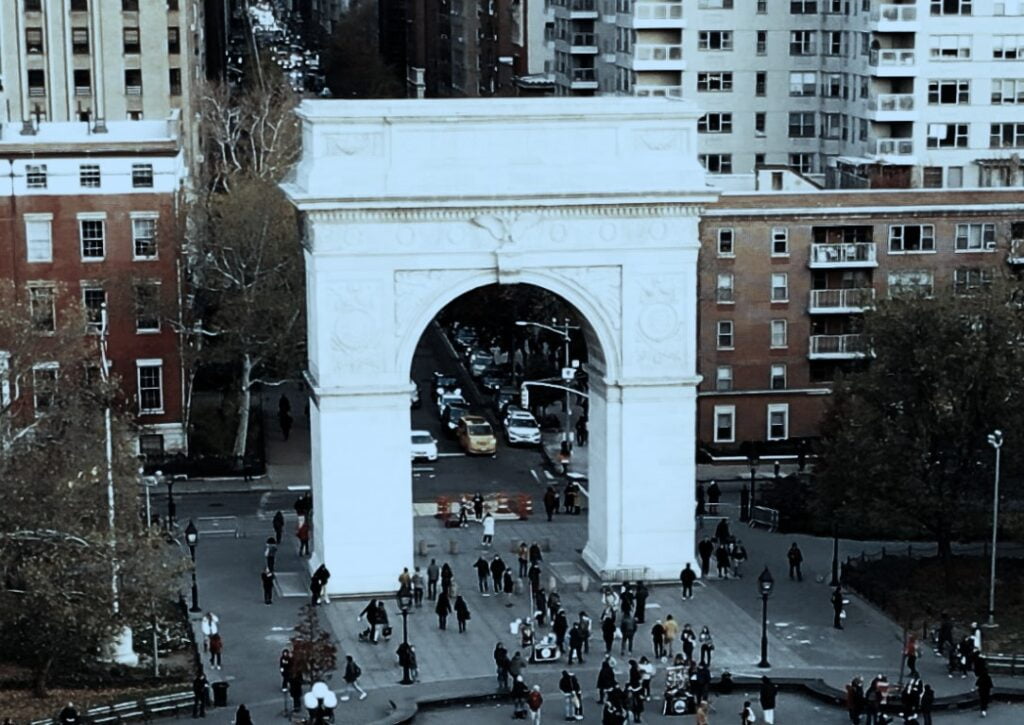Washington Square Park in Greenwich Village
Table of Contents

Origins and Early History
Revolutionary War and the Park's Namesake
Architectural Landmarks
The Washington Square Arch: The iconic Washington Square Arch, designed by architect Stanford White, stands at the park’s northern entrance. Modeled after the Arc de Triomphe in Paris, it was completed in 1892 to commemorate the centennial of George Washington’s inauguration as the first President of the United States.
Garibaldi Statue: At the center of the park, a statue of Giuseppe Garibaldi, an Italian revolutionary leader, serves as a symbol of the strong Italian-American presence in the Greenwich Village neighborhood. The statue was dedicated in 1888 and is a testament to the immigrant history of the area.
Holocaust Memorial: In the southeast corner of the park, a moving Holocaust Memorial, designed by Harriet Feigenbaum, pays tribute to the victims of the Holocaust and serves as a reminder of the atrocities committed during World War II.
Stanley S. Lefcourt Building: Adjacent to the park is the Stanley S. Lefcourt Building, a historic residential structure that adds to the architectural charm of the area.
Washington Square Park, NYC
Culture and Art in Washington Square Park
Greenwich Village, and by extension Washington Square Park, has a rich history as a gathering place for artists, writers, and musicians. During the late 19th and early 20th centuries, the park and its surroundings became a hub for creative and intellectual expression. Poets like Edna St. Vincent Millay and writers such as Henry James were drawn to the area, making it a hotbed for literary innovation.
Social and Political Movements
Washington Square Park has been a witness to and participant in numerous social and political movements throughout its history. The park played a central role in various civil rights and anti-war protests in the 1960s and 1970s. However, its most significant involvement came during the Stonewall riots of 1969, a turning point in LGBTQ+ history. The Stonewall Inn, located near the park, became a focal point for the modern LGBTQ+ rights movement.
Washington Square Park Notable Events and Timeline
To better appreciate the historical significance of Washington Square Park, let’s explore a timeline of key events and milestones.
1797: The park’s land is officially designated as a public space.
1826: Washington Square Park is officially named in honor of George Washington.
1871: The park undergoes a major redesign led by architect Jacob Wrey Mould, who added the iconic fountain, paths, and landscaping.
1889: The Washington Square Arch is erected to celebrate the centennial of George Washington’s inauguration.
1934-1963: The park’s fountain becomes a popular gathering place for chess players, artists, and activists, cementing its role as a center for free expression and public discourse.
1960s-1970s: The park is a hub for anti-Vietnam War protests, counterculture movements, and the civil rights struggle.
1969: The Stonewall riots near the park mark a turning point in the LGBTQ+ rights movement.
2000s: The park undergoes a series of renovations and improvements, maintaining its historical charm while modernizing facilities.
Video: Actor's Strike in Times Square
Contemporary Significance
Today, Washington Square Park remains a vibrant and bustling urban green space. It continues to host a wide array of events, from musical performances and art exhibitions to political rallies and social gatherings. Local residents, students from nearby New York University, and tourists all converge on the park to enjoy its scenic beauty and absorb the rich history that surrounds them.
Movies and Shows Shot in Washington Square Park
Movies
“When Harry Met Sally” (1989) – A memorable scene where Billy Crystal and Meg Ryan, sit on a bench near the arch.
“I Am Legend” (2007) – The park is featured in this post-apocalyptic science fiction film starring Will Smith.
“August Rush” (2007) – The park is featured in several scenes in this drama film about a young musical prodigy searching for his parents.
“Birdman” (2014) – The park is briefly seen in this great film starring Michael Keaton.
Shows
“Friends” – The park appears in several episodes of this popular sitcom, including the one where Ross plays the bagpipes.
“Law & Order: Special Victims Unit” – Various episodes of this long-running crime drama feature scenes shot in Washington Square Park.
“Mad About You” – The park is featured in episodes of this sitcom, as it is set in New York City.
“Nurse Jackie” – The park makes appearances in this medical drama series.
Bottom Line
Washington Square Park, with its rich historical tapestry, architectural landmarks, and role in fostering artistic and social movements, stands as an enduring testament to the spirit of Greenwich Village and the dynamic city of New York. It has evolved from its humble beginnings as a marshy burial ground to become a symbol of resilience, free expression, and the unending pursuit of progress. Whether you’re seeking a moment of reflection, cultural enrichment, or simply a scenic place to relax, Washington Square Park welcomes all to partake in its vibrant legacy.
As we stroll through the park, we can’t help but appreciate the layers of history that have accumulated over the centuries, making Washington Square Park not just a green space but a living, breathing chronicle of American history and culture.

